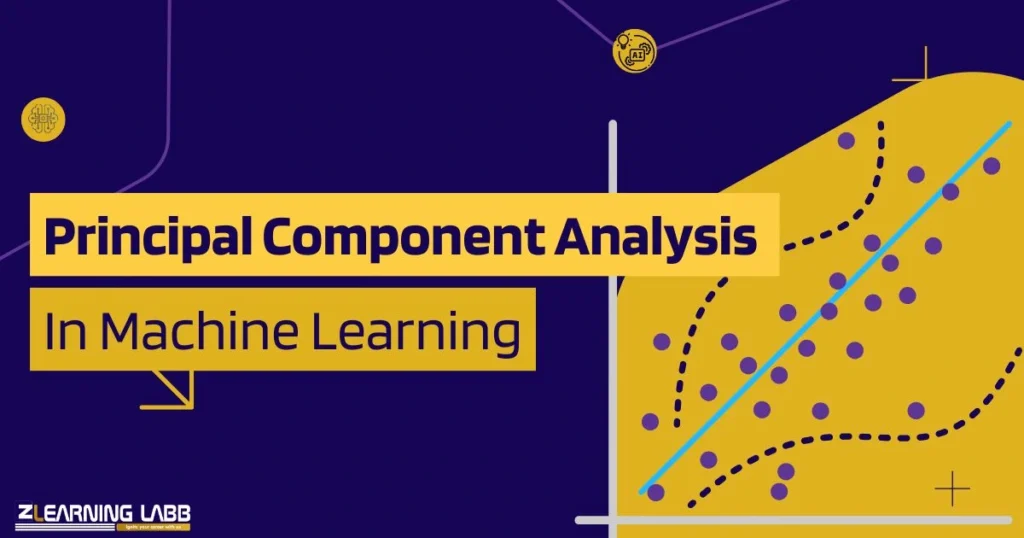Principal Component Analysis in Machine Learning: Have you ever stared at a large spreadsheet with hundreds of columns and wondered, “How do I even begin to make sense of this?” If yes, then you’re already halfway to understanding Principal Component Analysis in Machine Learning.
Who doesn’t deal with enormous datasets these days, right? The more features (columns) we have, the harder it gets for both humans and machines to interpret patterns. This is where Principal Component Analysis (PCA) steps in. It helps simplify data while keeping the most important information intact.
In this blog, we’ll unpack the concept of Principal Component Analysis in Machine Learning—from what it is and how it works, to real-world examples and applications. We’ll explain PCA full form in machine learning and walk through a principal component analysis step by step example, while also comparing it with factor analysis.
Plus, you’ll discover how PCA fits into image processing, and how it’s used for dimensionality reduction. And yes, we’re also introducing some helpful resources like Ze Learning Labb for mastering data science and analytics!
Here’s what’s inside:
- What is Principal Component Analysis in Machine Learning?
- How does PCA work?
- Principal Component Analysis for Dimensionality Reduction
- Key Applications of PCA
- PCA in Image Processing
- PCA vs Factor Analysis
- Real Dataset Example with PCA

What is Principal Component Analysis in Machine Learning?
First things first, PCA full form in machine learning is Principal Component Analysis.
Principal Component Analysis in Machine Learning is a technique used to reduce the number of variables in a dataset while retaining as much information as possible. It transforms the original features into a new set of features called principal components.
“Think of PCA as finding the best angles to view your data — so you see the full picture, but with fewer dimensions.”
Instead of analysing 100 features, PCA might reduce it to 10, without losing significant insights.
How Does Principal Component Analysis Work?
So, how does principal component analysis work, technically? It sounds fancy, but it follows a logical sequence.
Here’s a simplified principal component analysis step by step example:
- Standardize the data: Make sure each feature has a mean of 0 and standard deviation of 1.
- Calculate covariance matrix: This helps us understand the relationship between features.
- Calculate eigenvalues and eigenvectors: These help identify directions (components) of maximum variance.
- Choose top components: Pick the top k components that explain most of the variance.
- Transform data: Project the data onto these components.
This results in a dataset with fewer features but similar patterns.
Principal Component Analysis for Dimensionality Reduction
Now, one of the most common uses of PCA is dimensionality reduction.
But wait, why reduce dimensions?
- High-dimensional data leads to the curse of dimensionality—models get slow and overfit.
- Visualization becomes nearly impossible beyond 3D.
- It’s easier and faster to train models with fewer but meaningful features.
So, the main purpose of principal component analysis is to reduce the number of features while preserving essential information. This makes PCA a go-to method in preprocessing before machine learning model training.

Principal Component Analysis Application in Real Life
Let’s talk about principal component analysis application in various domains:
- Finance: Reducing stock indicators to identify trends.
- Healthcare: Analysing genetic data and lab tests.
- Marketing: Segmenting customers based on shopping behaviour.
- Agriculture: Understanding crop yield patterns from soil and weather data.
- Education: Simplifying exam results across subjects.
And yes, you guessed it—PCA in image processing is a big one!
Principal Component Analysis in Image Processing
Images are made up of thousands of pixels, and each pixel can be a feature.
For example, a 100×100 image = 10,000 features!
PCA helps reduce the size of this feature set while maintaining key image characteristics.
- Facial recognition: PCA is used in the “Eigenfaces” method to identify and differentiate faces.
- Image compression: Reducing image size without noticeable loss in quality.
- Noise removal: PCA filters out noise by keeping only the most significant components.
Difference Between Principal Component Analysis and Factor Analysis
People often get confused between PCA and factor analysis, and rightly so.
Let’s break it down:
| Features | PCA | Factor Analysis |
| Purpose | Data reduction | Identify latent variables |
| Based On | Variance | Covariance and shared variance |
| Components | Linear combinations of original features | Underlying factors |
| Output | Principal Components | Factors |
So, yes, there is a difference between factor analysis and PCA, and both have their unique uses. Still confused? Think of PCA as simplifying data for machines, and factor analysis as exploring hidden traits for humans.
Dataset for Principal Component Analysis – Real Example
Let’s look at a real dataset for principal component analysis.
Dataset: Wine Quality Dataset (available on UCI repository)
- Features: Alcohol, pH, acidity, sulphates, etc.
- Task: Reduce features to principal components and build a classification model.
After applying PCA:
- 11 features reduced to 3 components
- Retained over 85% of data variance
- Model accuracy improved due to noise reduction
This shows that principal component analysis in machine learning is more than a theory—it’s a real-world problem solver.
Is PCA Always the Right Choice?
Good question. While PCA is powerful, it’s not a one-size-fits-all.
Here are some things to keep in mind:
- PCA assumes linear relationships
- Components can be hard to interpret
- It may not work well if features are already independent
So before applying PCA, check your data, experiment with and without PCA, and compare the results.

Learn More with Ze Learning Labb
Ready to master PCA and other ML techniques? Ze Learning Labb offers beginner-friendly and advanced courses in:
- Data Science: Understand core ML concepts including PCA
- Data Analytics: Learn how to clean, transform, and reduce data
- Digital Marketing: Leverage analytics to enhance campaigns
Learning PCA gave me the confidence to handle complex datasets with ease. Ze Learning Labb made it simple and practical.
Visit Ze Learning Labb and start your journey today.
On A Final Note…
Principal component analysis in machine learning is your go-to tool for simplifying complex data. It’s used in everything from finance to image recognition. Understanding the difference between PCA and factor analysis helps you choose the right tool.
The main purpose of principal component analysis is to reduce dimensions while keeping the core message of the data. If you’re working with high-dimensional data and want faster, cleaner models—PCA is your best friend.
So, next time you face a giant dataset, don’t stress. Just PCA it.





